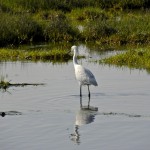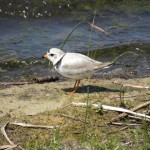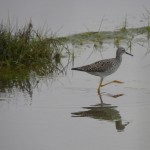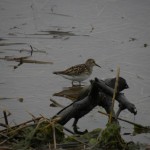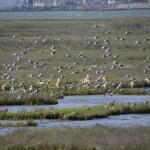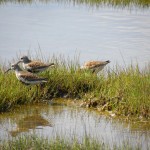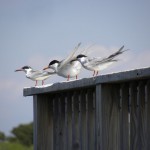8 August 2013. Port Maitland ON. The Short-billed and the Long-billed Dowitchers are closely related, almost identical shorebirds, so alike that it takes pages of the best references to tease out the fine distinguishing details. I have a 1905 field guide which includes a footnote to the Dowitcher which reads: “Long-billed Dowitcher is found in western N.A. The bill is supposed to be longer, but the plumage is identical and the birds probably are’. So somewhere along the way the two were declared to be separate species, which leaves us trying to figure out which is which.
Distinguishing those differences in the field is a tough go for most birders, especially when you’re looking across a mudflat to the distant far side where most shorebirds hang out. Geography helps a bit, exactly where you are in North America in relation to the species’ distribution and migratory patterns sometimes helps; it so happens that we’re in an area where Short-billed Dowitchers are the default species. In other parts of the continent it’s not so cut and dried and to complicate matters there are distinct sub-species of the Short-billed Dowitcher. At risk of belabouring the whole matter I quote from Pete Dunne’s analysis, “The degree of difference between Short-billed and Long-billed also varies between subspecies. The Atlantic form of Short-billed is most unlike Long-billed in size, shape and breeding plumage; the prairie form most closely resembles Long-billed in breeding plumage and the pacific form comes closest to long-billed in size.” Does that help?
It’s too much for me and I think local birders are on pretty safe ground to call any dowitcher a Short-billed Dowitcher. That’s what I did today.
But what of the day? I took a trip to some open mudflats and once I’d made my peace with the affable guardian in the Ford F150 pick-up, I enjoyed some excellent shorebird watching. 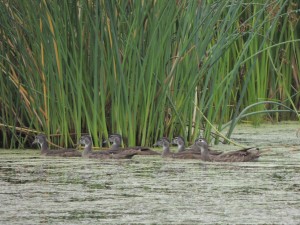
I stopped first at a weed-clogged pond where a hen Wood Duck was shepherding her brood around. The babes have all grown up, they’re the same size as mum, but obedient nevertheless. Nearby a family of Eastern Kingbirds and loose groups of Barn Swallows found lots of flying insects to pick from the water lily leaves.
At the mudflats, an adult Bald Eagle flew heavily from left to right and set the shorebirds scattering for a few minutes, but they eventually calmed down, so I set up my telescope.
It was marvelous: lots of beautiful classic Greater Yellowlegs, they were easily distinguished from just as many Lesser Yellowlegs. A few Pectoral Sandpipers showing their crisp brown bibs, some busy invertebrate-picking Semi-palmated Sandpipers, and a group of five or six Short-billed Dowitchers. The sight of them made me gasp they were so plump and orangey, so perfectly-shorebirdish, so Bird of the Day.
Then my telescope broke and took the fun out of it all. Without it I have NO hope of even teasing myself with shorebird i.d.
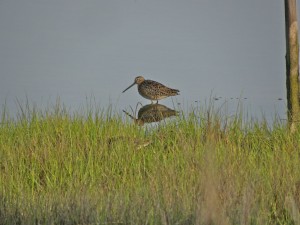
However all is not lost, there’s always spring birding along the Atlantic coast. A little over a year ago I was on the New Jersey shore at a place called Stone Harbor, nearby were many other nautical place names like : Carnival Bay and Long Reach and what they all had in common was streets lined with seaside condo-homes and shops stuffed full of gifts, sunglasses and T-shirts. All of which incidentally was virtually wiped off the map five months later by Hurricane Sandy. But anyway when I was there, Arctic-bound Short-billed Dowitchers were quite abundant and easily approached along the edges of the inner harbour salt marshes. Here are some photos of various shorebirds from that visit but you’ll only be able to see them if you’re logged on the website, not if viewed as an email.
